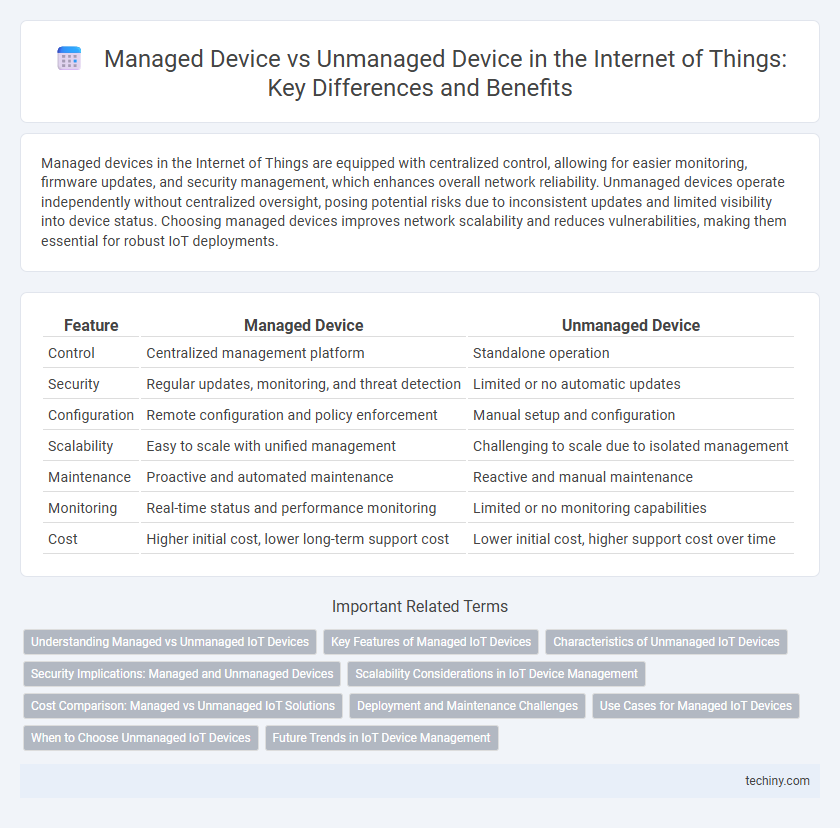Managed devices in the Internet of Things are equipped with centralized control, allowing for easier monitoring, firmware updates, and security management, which enhances overall network reliability. Unmanaged devices operate independently without centralized oversight, posing potential risks due to inconsistent updates and limited visibility into device status. Choosing managed devices improves network scalability and reduces vulnerabilities, making them essential for robust IoT deployments.
Table of Comparison
| Feature | Managed Device | Unmanaged Device |
|---|---|---|
| Control | Centralized management platform | Standalone operation |
| Security | Regular updates, monitoring, and threat detection | Limited or no automatic updates |
| Configuration | Remote configuration and policy enforcement | Manual setup and configuration |
| Scalability | Easy to scale with unified management | Challenging to scale due to isolated management |
| Maintenance | Proactive and automated maintenance | Reactive and manual maintenance |
| Monitoring | Real-time status and performance monitoring | Limited or no monitoring capabilities |
| Cost | Higher initial cost, lower long-term support cost | Lower initial cost, higher support cost over time |
Understanding Managed vs Unmanaged IoT Devices
Managed IoT devices offer centralized control, remote monitoring, and enhanced security through consistent firmware updates and policy enforcement, making them ideal for enterprise environments requiring reliability and compliance. Unmanaged IoT devices lack such oversight, often operating independently without remote access or automated maintenance, increasing vulnerability to security breaches and inconsistent performance. Understanding these differences is crucial for deploying scalable and secure IoT networks tailored to specific operational needs.
Key Features of Managed IoT Devices
Managed IoT devices offer centralized control, enhanced security protocols, and real-time monitoring capabilities that ensure optimal performance and swift issue resolution. They support remote configuration, firmware updates, and policy enforcement, facilitating scalable device management across diverse networks. These devices typically integrate advanced analytics and automatic alerts, improving operational efficiency and reducing downtime in IoT ecosystems.
Characteristics of Unmanaged IoT Devices
Unmanaged IoT devices typically lack centralized control and monitoring, leading to limited security updates and configuration management. These devices often operate independently, increasing vulnerabilities due to inconsistent firmware versions and absence of automated threat detection. Their simplicity in deployment contrasts with challenges in scalability and risk mitigation across extensive IoT networks.
Security Implications: Managed and Unmanaged Devices
Managed devices in the Internet of Things (IoT) environment offer centralized security controls, regular firmware updates, and proactive threat monitoring to mitigate vulnerabilities. Unmanaged devices lack consistent security oversight, increasing the risk of unauthorized access, data breaches, and exploitation by cyber attackers. Enterprises deploying IoT networks must assess the security implications of unmanaged versus managed devices to ensure robust protection and compliance with regulatory standards.
Scalability Considerations in IoT Device Management
Managed devices in IoT offer centralized control and automated updates, which significantly enhance scalability by allowing seamless integration of thousands of devices without manual intervention. Unmanaged devices lack remote monitoring and configuration capabilities, leading to challenges in scaling due to increased maintenance overhead and difficulty in maintaining consistent security policies. Efficient IoT device management relies on managed devices to ensure scalable, secure, and streamlined deployment across expanding networks.
Cost Comparison: Managed vs Unmanaged IoT Solutions
Managed IoT devices typically involve higher upfront costs due to integrated monitoring, security, and maintenance services, while unmanaged devices incur lower initial expenses but can lead to increased long-term operational costs and security risks. Investing in managed IoT solutions reduces downtime and maintenance efforts, offering predictable budgeting through subscription models or service contracts. Unmanaged devices may require dedicated IT resources and face potential data vulnerabilities, resulting in hidden costs that surpass their initial affordability.
Deployment and Maintenance Challenges
Managed devices in IoT environments simplify deployment by offering centralized control, automated updates, and consistent security policies, reducing overhead and downtime. Unmanaged devices lack remote monitoring, leading to complex maintenance, increased manual interventions, and higher risk of vulnerabilities across large-scale IoT networks. Efficient deployment and maintenance of managed devices enhance scalability and reliability in industrial and smart city IoT applications.
Use Cases for Managed IoT Devices
Managed IoT devices enable real-time monitoring and remote control, essential for applications like smart cities, industrial automation, and healthcare, where reliability and security are critical. These devices support firmware updates, configuration management, and anomaly detection, reducing downtime and operational costs. Use cases include predictive maintenance in manufacturing, remote patient monitoring in healthcare, and asset tracking in logistics.
When to Choose Unmanaged IoT Devices
Unmanaged IoT devices are ideal for simple, cost-sensitive applications where basic connectivity and limited control are sufficient, such as in smart home sensors or straightforward monitoring systems. They require minimal configuration and maintenance, making them suitable for deployments with low technical expertise or budget constraints. Choosing unmanaged devices reduces complexity and upfront costs while ensuring essential functionality in environments with stable, predictable network conditions.
Future Trends in IoT Device Management
Future trends in IoT device management emphasize enhanced security protocols for managed devices, leveraging AI-driven analytics to predict and mitigate vulnerabilities. Unmanaged devices pose risks due to lack of centralized control, prompting advancements in automated discovery and classification techniques. The integration of edge computing and blockchain technology ensures scalable, transparent, and tamper-proof IoT ecosystems.
Managed device vs Unmanaged device Infographic

 techiny.com
techiny.com